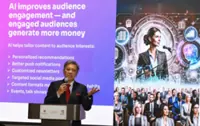The age of the human trader could be fading now that artificial intelligence is playing an increasing role in helping investors identify market trends and determine what stocks to buy and sell. — Photo by Nicholas Cappello on Unsplash
A handful of money managers are banking on a robot that works continuously day and night, but only gives its advice on stocks once a week - each Monday morning before the opening bell on Wall Street.
The algorithm – built by the North Side tech firm StockSnips – is trained to read and process more than 50,000 media articles a day before picking stocks based solely on how companies are being talked about in the news.




